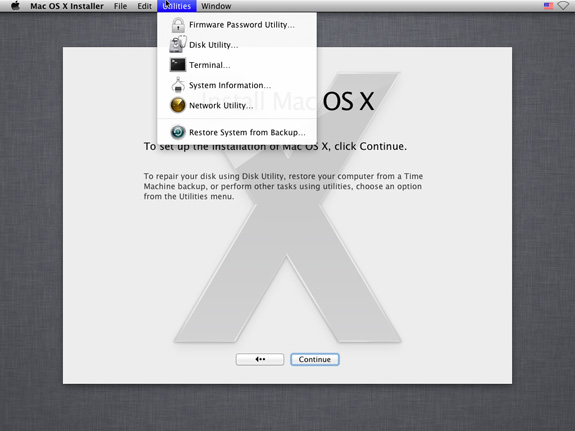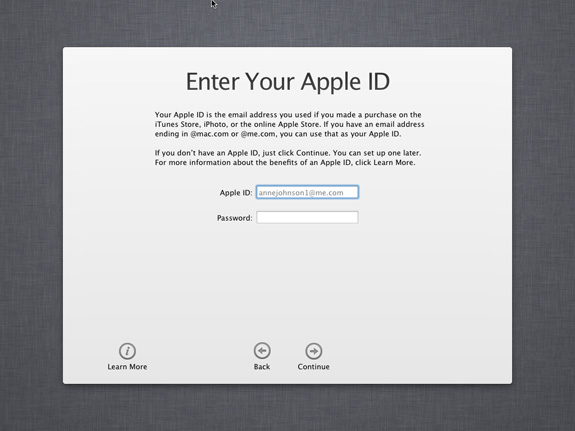Back to the Mac: OS X 10.7 Lion Review
by Andrew Cunningham, Kristian Vättö & Anand Lal Shimpi on July 20, 2011 8:30 AM ESTLike Windows 7, the Lion installer creates a small hidden system partition on your hard drive - in Lion, this recovery partition is to be used in lieu of your install CD in the event that you need to run diagnostics or reinstall your OS (if you burned Lion to a DVD, booting from it will get you the same interface and tools as the recovery partition, so pay attention). This partition is normally hidden from the end user in the Finder and Disk Utility, but is selectable when pressing the alt/option key at boot (and visible in System Profiler as a 650MB partition on your hard drive).

Missing from this list are the System Profiler and the Password Reset utility - I don’t know why the former is gone, but the latter is presumably missing for security reasons, since basically anyone armed with the Password Reset utility and physical access to your machine can change any local account’s password at will. To replace the functionality of this tool, Lion now gives you the option to recover your account password if you associate it with your Apple ID, which should work fine for most individuals (though perhaps not so much for system administrators).
If you didn’t burn a disc as outlined previously, the recovery partition also gives you your only option for a clean install of Lion - erase your hard drive using Disk Utility and then elect to install a fresh copy of Lion. At this point, you will be prompted for your Mac’s serial number, which is then communicated to Apple, and if it clears your Mac will re-download (sigh) and re-install the OS. This serial number check is OS X’s first real implementation of what anyone could call activation, though it’s worth noting that if you install Lion from a .DMG copied to another disk, the OS will still install without any checks.
The last thing the recovery partition is used for is to store FileVault information, which we’ll talk more about later on in the review.
Once the installer is complete, people who did an upgrade install will be able to start using Lion pretty much immediately - aside from the (optional) registration form, there’s not really anymore to it. People who did a clean install (or who have new Macs preloaded with Lion) will be taken through the standard first-time setup process, which is mostly identical to that of OS X versions past with a couple of changes: first, the customary OS X welcome movie has been completely removed (possibly in another effort to save on download size). Second, users are now given the option to associate their Mac with an Apple ID, and to give that Apple ID the ability to recover their local account password. Last, on Macs with multitouch-enabled trackpads and mice, the OS literally forces you to use a two-fingered scrolling gesture to click the “Start Using OS X” button. How’s that for pushing new features?












106 Comments
View All Comments
ebolamonkey3 - Thursday, July 21, 2011 - link
Well, since Apple retains 30% of the App price, I'm not sure if that figure above is talking about the total amount that customers have spent buying songs and apps, or if that's Apple's revenue (ie: 30% cut) of the pie.PreOmegaZero - Wednesday, July 20, 2011 - link
Microsoft names the OS versions as such (6.0 vs 6.1) because changing it to 7.0 (like they admit they should have done) broke many older apps/installers that did OS version detection.So the version numbering is simply from a compatibility standpoint.
darwinosx - Wednesday, July 20, 2011 - link
These aren't service packs. Its a silly comment which tells us you either don't know what a service pack (which is a Microsoft term for Microsoft software) actually contains or you didn't read this review.Belard - Thursday, July 21, 2011 - link
Service packs? Apple uses actual version numbers, but in the past few years - they've only been patching Snow Leopard.The difference in XP SP1 / SP2 / SP3 is bug fixes, security patches and a few things here and there, but feature wise, no difference. XP-Home/Pro are visually different than XP-MCE (Which is XP Pro with a nice visual face lift but with VPN ripped out).
I think Apple charges like $50 for a 5 user license upgrade... much better than the lame Win7 (Vista and XP) charging $100 for an upgrade disk which is messy when it comes to a clean install.
anactoraaron - Sunday, July 24, 2011 - link
"much better than the lame Win7 (Vista and XP) charging $100 for an upgrade disk which is messy when it comes to a clean install."You have no clue about which you speak. Win7 upgrades/clean installs are simple for even the simplest minds-present party excluded apparently.
name99 - Thursday, July 21, 2011 - link
An improvement? Uhh, you are aware that Snow Leopard ALSO sold for $29?The more interesting points you should be making are that:
- $29 gets you the right to install the OS on EVERY mac you own. It's right there in the TOS. For most people this won't matter much, but for those with a desktop machine, a laptop and a HTPC, it's rather cool.
- and you get the right to virtualize two instances, if you care
- and note the conspicuous absence of any sort of DRM covering the OS, not to mention the home/home mini/pro/ real pro/enterprise/super singing & dancing version crap that MS offers up.
(And, BTW, you get the Dev Tools for free. They were $5 in SL, but I think they've dropped to $0 with Lion.
As far as I know, Dev Studio is not free, not close.)
ATimson - Thursday, July 21, 2011 - link
Assuming that by "Dev Studio" you mean "Microsoft Visual Studio", yes, they have a fully-functional free version.name99 - Thursday, July 21, 2011 - link
How come when I go tohttp://www.microsoftstore.com/store/msstore/en_US/...
I see a bunch of different prices, from $3,800 to $400, but no $0?
I'm not being pissy, I really want to understand what is going on here.
Ryan Smith - Friday, July 22, 2011 - link
How can you buy something that's free?http://www.microsoft.com/visualstudio/en-us/produc...
kosmatos - Monday, November 4, 2013 - link
It's 2013 now, and you were spot on, quicksilvr.